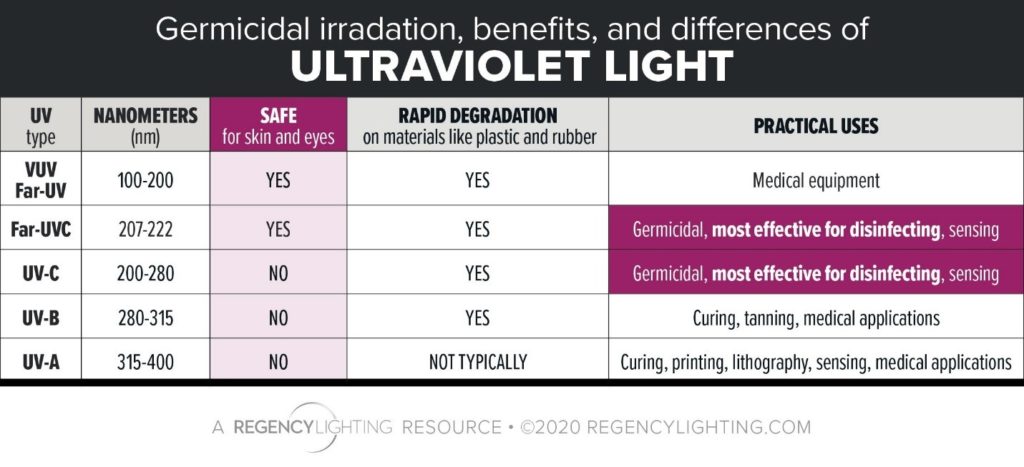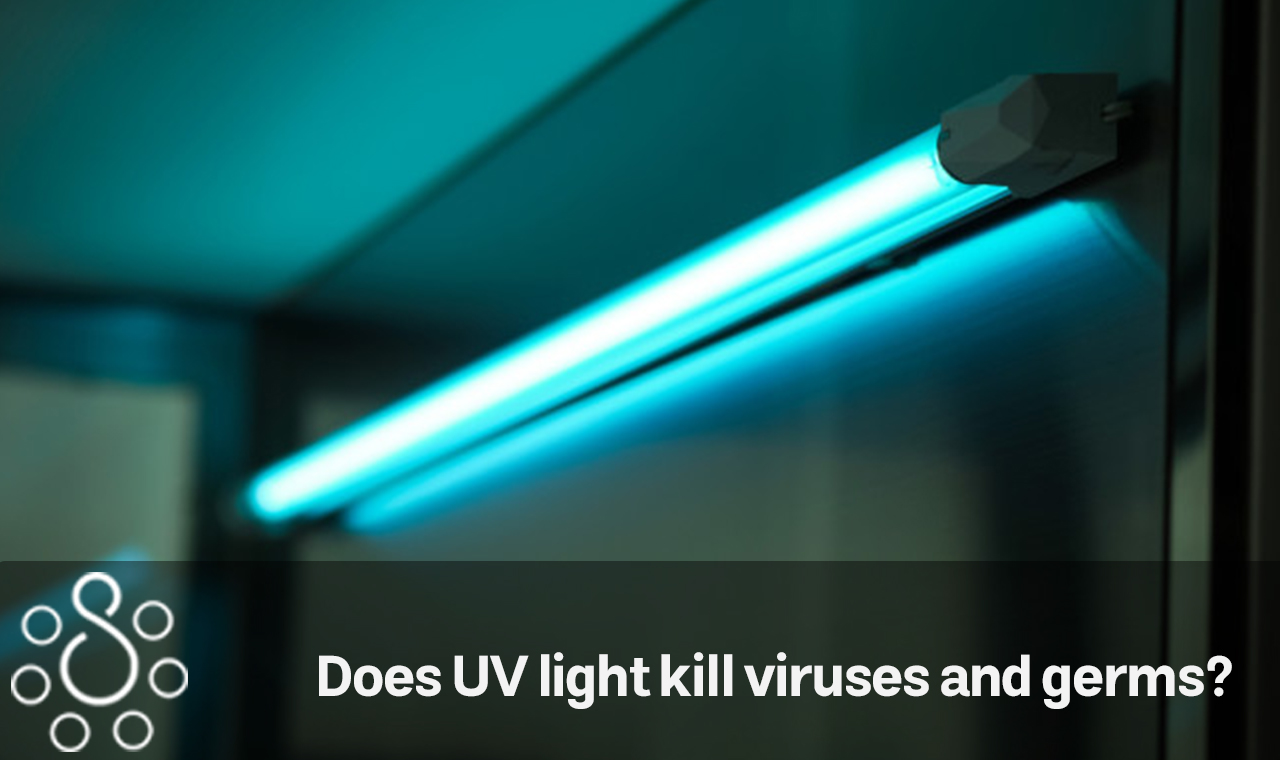During the current coronavirus epidemic, ultraviolet (UV) light disinfection is receiving a great deal of interest. The most significant advantage is its capacity to eliminate diseases such as viruses and bacteria. According to some experts, UV goods might aid in the recovery of our economy while also helping to maintain public spaces clean and safe. You’re undoubtedly aware with the terms ultraviolet A and ultraviolet B. Sunlight rays strike the Earth’s surface, and it is for this reason that physicians prescribe that we use sunscreen. Other forms of UV that are often employed in disinfecting lighting goods may be unfamiliar to you. In this paper you will find how UV light kills microbes in the following topics:
Does UV light kill viruses and germs?
UV-C or germicidal UV
Downes and Blunt discovered the antimicrobial properties of sunshine almost 140 years ago. Shorter wavelengths of the sun’s spectrum were shown to be more efficient in neutralizing germs. UV-C, UV-B, UV-A, and violet blue light are now recognized to have germicidal properties. Violet Defense’s technology adds to this study by introducing a new, unique way to make UV and violet blue light more effective and useful in everyday situations.

UV has had the ability to disinfect for decades, and scientists have recognized this for decades. According to experts, it is now regarded as a critical instrument in the battle against COVID-19. In experimental conditions, a scientist from Columbia University discovered that ultraviolet C is effective against SARS-CoV-2, the virus that causes COVID-19.
UV-C, often known as germicidal ultraviolet light, has wavelengths ranging from 200 to 280 nanometers. This is the classic kind of germicidal ultraviolet light that has been used to disinfect water, air, and surfaces for more than a century by scientists to disinfect water, air, and surfaces. Germicidal UV is very efficient in destroying and deactivating all types of pathogens such as viruses, bacteria, mold, and fungi. According to preliminary findings, the virus that causes COVID-19, SARS-CoV-2, has been shown to be inactivated by ultraviolet C.
Related Article: Is UV Sanitizer Safe? Things You Need to Know

Even while UV-C disinfection is a very successful disinfection method, it is not without its risks. People who use a lot of UV-C products use 254 nm wavelengths, which can get into the skin and eyes.The sun’s ultraviolet C rays may cause skin burns. Most of the items should only be used in rooms that aren’t being used, which may be difficult for industries that don’t have a lot of downtime, like the pharmaceutical industry.
What is the mechanism through which germicidal UV light kills viruses?
DNA and RNA are the genetic materials that make up all living things, and they are responsible for directing their growth, development, functioning, and reproductive processes. UV light emits electromagnetic radiation that has the potential to impair the capacity of microorganisms to reproduce as well as induce inactivation of bacteria by producing mutations and/or cell death in the organisms exposed to it. Radiation from UV generates electromagnetic energy that may damage the capacity of bacteria to reproduce and cause photochemical reactions in nucleic acids, among other things (DNA and RNA).
Related Article: Why We Need UV-C Disinfection

Germicidal UV products have the power to alter the DNA and RNA of bacteria and viruses, preventing them from reproducing and spreading. The majority of UV-C products are capable of inactivating pathogens such as viruses, bacteria, mold spores, and fungus up to 99.9% of the time. Viruses are not technically living beings; therefore, germicidal ultraviolet light “inactivates” them in a technical sense. Germicidal UV is an excellent tool for disinfecting the air and surfaces, since, for example, COVID-19 may survive on some surfaces for up to three days and can spread through the air.
Despite the fact that the technology underpinning germicidal UV has been available for a long time, it has only lately been extensively employed in the United States. In the early 2000s, the Centers for Disease Control and Prevention (CDC) and the Federal Emergency Management Agency (FEMA) began to recommend its usage in hospitals. Many medical evaluations have now highlighted that the efficacy of the drug has increased, and that its use has increased dramatically in the previous 13 years. Hospitals, medical laboratories, elderly care facilities, fire and police stations, airports, transit stations, schools, government buildings, business buildings, and hotels all benefit from them because of their efficacy.
In recent years, technology has evolved to incorporate new items that may be used in a variety of businesses other than just hospitals. According to a Columbia University expert, ultraviolet light may likewise be used to inactivate COVID-19. In light of the fact that COVID-19’s structure is distinct from previous viruses, this testing is highly essential. In addition, it is vital to highlight that germicidal ultraviolet light does not substitute other cleaning procedures such as dusting surfaces. In real life, germicidal UV treatments can’t get through small particles like dust, so their effectiveness will be lower on dirty surfaces.
Is it safe to use germicidal UV light?
UV-C rays, like UV-A and UV-B rays from the sun, may cause skin and eye damage. When the items are in use, certain safety rules must be followed. As a general rule, germicidal UV lights should not be used while people are present. According to the IES, there have been no instances of long-term harm from unintentional overexposure, although there may be unpleasant immediate repercussions. Only skilled personnel should handle germicidal UV devices, and the product should be switched off before conducting maintenance. You also need to get the right light bulb for the right fixture and follow the manufacturer’s product use instructions when you buy and use the product.
Another strategy for remaining safe while exposed to UV-C radiation is to use the proper personal protection equipment (PPE). UV-C-sensitive personal exposure stickers are also available to assist in warning when someone working with UV-C light has exceeded the maximum daily exposure limit.
The Benefits of Germicidal UV
Germicidal UV lights are incredibly effective and offer a number of significant benefits.
- Pathogen kill rate: Tests indicate that when used appropriately, germicidal UV products destroy up to 99.9% of bacteria, mold, fungi, and even viruses, rapidly.
- Germs and pathogens cannot develop resistance to UV, as they may to some medicines and antibacterial treatments.
- No chemicals: UV-C operates in lieu of potentially dangerous chemicals, so there is less chemical exposure. It is okay to enter a room after germicidal UV treatments have disinfected it, although it may be difficult to breathe in a room that has just been sprayed with chemicals.
- Lighting configurations: Germicidal UV light lighting setups include various forms of fixture installation, mobile units, and industrial HVAC attachments. Because they are portable, mobile units are an excellent choice for hospitals, airports, fire and police stations, and the hospitality sector. Furthermore, as compared to putting fixtures in every room, transportable units are a more cost-effective solution.
Environmentally-friendly and affordable
Is it possible for germicidal UV to damage materials or surfaces?
The sun’s UV rays are known to degrade things, which is why leaving a toddler’s plastic toys outdoors throughout the summer causes the colors to fade and the plastic to become more brittle. Similarly, UV-C and wide spectrum products may cause long-term harm to materials. The key distinction to look for is whether the UV radiation is continuous or provides brief bursts or pulses of disinfecting UV rays. Constant UV radiation, in most situations, will only cause aesthetic harm to items or surfaces. A white PVC pipe, for example, may change color to tan or brown while retaining structural integrity.
How can you detect whether UV light kills viruses like COVID-19?
The optimal dosage for UV products is determined by two major factors: intensity and time. The greater the intensity, the shorter the time required to destroy pathogens such as viruses and bacteria. Products with lower intensities will need more time to achieve the same amount of disinfection. A higher-power UV device may allow you to clean an area faster than a low-power one. This is one of the reasons high-power mobile units are often used in healthcare settings. The distance between you and the UV light is also significant. Surfaces farther away from the UV product will not be disinfected to the same extent as those closer to it.

There are several rules to follow to better comprehend the relationship between time, intensity, and distance. Once you’ve determined the proper dose, there are a few methods for determining how much UV radiation a surface has gotten. A UV-C dosimeter is a device that changes color depending on the quantity of UV-C light that strikes it.
Depending on the intended usage, dosimeters are available in a number of configurations. If you use a card, the yellow region in the center of the dosimeter changes color depending on the intensity. If you use a sticker, the color of the sticker will vary depending on its intensity. When you look at this, you will know if the dosage is strong enough to kill or destroy certain viruses and bacteria.
Another option is to install a meter to ensure that your bulbs are working correctly. This may also alert you when it’s time to replace burned-out UV lights safely. Meters may be placed and monitored by your current team or by a professional.

M: UV-C or germicidal UV is a kind of UV light that kills viruses and germs, especially COVID-19. The related mechanism and its safety are important. Rather than chemicals, UV light has several benefits. There are some ways to detect whether germicidal UV kills viruses.

